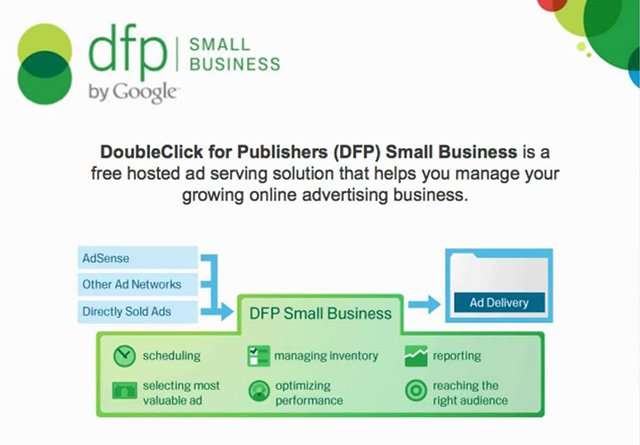Learning Center
What Is Google DFP?
When publishers are ready to explore beyond Google AdSense and perhaps one or two ad networks, they’ve probably caught wind of a service known as Google DFP. Just what is it, and how can it help you earn more money?

What is Google DFP?
Google DFP stands for DoubleClick for Publishers. Google bought DoubleClick for $3.1 billion dollars in April 2007. DoubleClick had developed what is known today as an ad server, and Google saw that as the future of online advertising. Google was right.
Now, as you look toward the future for your own site, you’re likely aiming to harness the power of an ad server. While there are other options, I recommend Google DFP SB (Small Business), unless you’re serving 30+ million pageviews monthly or have very specific needs. Best of all, the SB version of Google DFP is free, pending a Google AdSense account in good standing.
How Google DFP Helps You Earn More Money
Let’s play out two scenarios. Publishers A and B have relationships with the same 4 networks outlined below. For comparison sake, we’ll assume their monthly page views, number of ads, ad sizes, ad locations, network eCPMs and network fill rates are identical. Publisher A uses an ad server, while Publisher B simply places the network tags directly on their pages.
NOTE: If you don’t understand how the above concepts affect publisher revenue, consider visiting our Digital Advertising for Publishers Primer.
- Network A pays a $5.00 eCPM with 5% fill rate
- Network B pays a $2.50 eCPM with 10% fill rate
- Network C pays a $1.00 eCPM with 50% fill rate
- Network D pays a $0.50 eCPM with 100% fill rate
Assuming 100,000 page views (therefore 100,000 possible ad impression from each network) Publisher B, who simply places the network tags directly on their pages, would earn the following from each network:
- Network A – ((100,000 * 5%) = 5,000 / 1000) = (5 * $5.00) = $25.00
- Network B – ((100,000 * 10%) = 10,000 / 1000) = (10 * $2.50) = $25.00
- Network C – ((100,000 * 50%) = 50,000 / 1000) = (50 * $1.00) = $50.00
- Network D – ((100,000 * 100%) = 100,000 / 1000) = (100 * $0.50) = $50.00
Total revenue = $150.00
Total impressions = 165,000
eCPM = $0.91 ($150 / (165,000 / 1000))
Assuming the same 100,000 page views, Publisher A, who uses an ad server, would earn the following from each network:
- Network A – ((400,000 * 5%) = 20,000 / 1000) = (20 * $5.00) = $100.00
- Network B – ((380,000) * 10%) = 38,000 / 1000) = (38 * $2.50) = $95.00
- Network C – ((342,000) * 50%) = 171,000 / 1000) = (171 * $1.00) = $171.00
- Network D – ((171,000) * 100%) = 171,000 / 1000) = (171 * $0.50) = $85.50
Total revenue = $451.50
Total impressions = 400,000
eCPM = $1.12 ($451.50 / (400,000 / 1000))
Double-check the math, but that looks like three times the earnings! What happens is that Network A is given the opportunity to serve a $5.00 CPM ad to all 400,000 ad impressions. Network B then has the opportunity to serve a $2.50 CPM ad impression when Network A was unable to. Network B then passes the opportunity to Network C, and finally Network C to Network D.
Besides increasing the overall number of ad impressions served, the eCPM was driven higher as well because those higher paying ad networks got a chance at more impressions. Even at Publisher B’s 165,000 ad impressions, Publisher A would have earned $184.80 instead of $150.00.
You can see through this example that it pays to “layer”, “daisy-chain”, or “stack” your ads. Know that you don’t necessarily require an ad server to do this if the networks you work with allow you to set up your own pass back tags and a floor CPM. However, managing the pass back tags on your own takes much more coordination and effort than if you ran all these through an ad server like Google DFP SB.
We’ll end this section by emphasizing that not all ad networks and ad servers are created equally. As much as you’d like to think all this technology and communication is rock solid, its still got a ways to go. Know that you will lose ad impressions in each pass back from one ad server to another. How many you lose and the benefit of having a particular network in your “daisy-chain” requires a strong understanding of this concept and typically requires daily monitoring.
Well, that’s it! Now you know what Google DFP is and the concepts that shape its core service as an ad server. If you enjoyed this brief session and want to dive in to ad serving yourself, you can get started at google.com/dfp. However, if you prefer to focus on your content and marketing, we’re happy to put our 14 years experience to work for you and manage and optimize your ad networks. Simply complete our publisher application and we’ll be in touch within 2 business days.
Have further questions? Would you like us to elaborate on a particular subject? Ask your questions or request additional learning center content in the comments below.

0 Comments